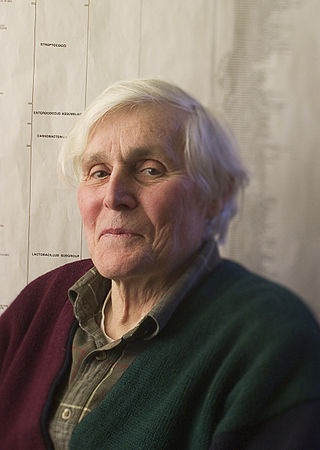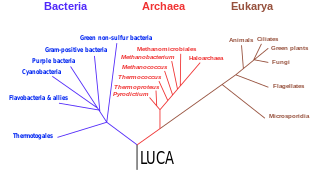Related Research Articles

Walter Gilbert is an American biochemist, physicist, molecular biology pioneer, and Nobel laureate.

Carl Richard Woese was an American microbiologist and biophysicist. Woese is famous for defining the Archaea in 1977 through a pioneering phylogenetic taxonomy of 16S ribosomal RNA, a technique that has revolutionized microbiology. He also originated the RNA world hypothesis in 1967, although not by that name. Woese held the Stanley O. Ikenberry Chair and was professor of microbiology at the University of Illinois Urbana–Champaign.

Bacteriology is the branch and specialty of biology that studies the morphology, ecology, genetics and biochemistry of bacteria as well as many other aspects related to them. This subdivision of microbiology involves the identification, classification, and characterization of bacterial species. Because of the similarity of thinking and working with microorganisms other than bacteria, such as protozoa, fungi, and viruses, there has been a tendency for the field of bacteriology to extend as microbiology. The terms were formerly often used interchangeably. However, bacteriology can be classified as a distinct science.

The three-domain system is a biological classification introduced by Carl Woese, Otto Kandler, and Mark Wheelis in 1990 that divides cellular life forms into three domains, namely Archaea, Bacteria, and Eukarya. The key difference from earlier classifications such as the two-empire system and the five-kingdom classification is the splitting of Archaea from Bacteria as completely different organisms. It has been challenged by the two-domain system that divides organisms into Bacteria and Archaea only, as Eukaryotes are considered as one group of Archaea.
In bioinformatics, sequence analysis is the process of subjecting a DNA, RNA or peptide sequence to any of a wide range of analytical methods to understand its features, function, structure, or evolution. Methodologies used include sequence alignment, searches against biological databases, and others.

The Thermoproteota are prokaryotes that have been classified as a phylum of the Archaea domain. Initially, the Thermoproteota were thought to be sulfur-dependent extremophiles but recent studies have identified characteristic Thermoproteota environmental rRNA indicating the organisms may be the most abundant archaea in the marine environment. Originally, they were separated from the other archaea based on rRNA sequences; other physiological features, such as lack of histones, have supported this division, although some crenarchaea were found to have histones. Until recently all cultured Thermoproteota had been thermophilic or hyperthermophilic organisms, some of which have the ability to grow at up to 113°C. These organisms stain Gram negative and are morphologically diverse, having rod, cocci, filamentous and oddly-shaped cells.
In arithmetic combinatorics, Szemerédi's theorem is a result concerning arithmetic progressions in subsets of the integers. In 1936, Erdős and Turán conjectured that every set of integers A with positive natural density contains a k-term arithmetic progression for every k. Endre Szemerédi proved the conjecture in 1975.
Andreas Roland Grüntzig was a German radiologist and cardiologist, with foundational interest, training and research in epidemiology and angiology. He is known for being the first to develop successful balloon angioplasty for expanding lumens of narrowed arteries. He was born in Dresden.
Raymond Vahan Damadian was an American physician, medical practitioner, and inventor of the first NMR scanning machine.

The two-empire system was the top-level biological classification system in general use before the establishment of the three-domain system. It classified cellular life into Prokaryota and Eukaryota as either "empires" or "superkingdoms". When the three-domain system was introduced, some biologists preferred the two-superkingdom system, claiming that the three-domain system overemphasized the division between Archaea and Bacteria. However, given the current state of knowledge and the rapid progress in biological scientific advancement, especially due to genetic analyses, that view has all but vanished.

Dideoxynucleotides are chain-elongating inhibitors of DNA polymerase, used in the Sanger method for DNA sequencing. They are also known as 2',3' because both the 2' and 3' positions on the ribose lack hydroxyl groups, and are abbreviated as ddNTPs.

Hillel "Harry" Furstenberg is a German-born American-Israeli mathematician and professor emeritus at the Hebrew University of Jerusalem. He is a member of the Israel Academy of Sciences and Humanities and U.S. National Academy of Sciences and a laureate of the Abel Prize and the Wolf Prize in Mathematics. He is known for his application of probability theory and ergodic theory methods to other areas of mathematics, including number theory and Lie groups.

Neomura is a possible clade composed of the two domains of life of Archaea and Eukaryota. The group was named by Thomas Cavalier-Smith in 2002. Its name means "new walls", reflecting his hypothesis that it evolved from Bacteria, and one of the major changes was the replacement of peptidoglycan cell walls with other glycoproteins. As of August 2017, the neomuran hypothesis is not accepted by most workers; molecular phylogenies suggest that eukaryotes are most closely related to one group of archaeans and evolved from them, rather than forming a clade with all archaeans, and that Archaea and Bacteria are sister groups.

George Edward Fox is an astrobiologist, a Professor Emeritus and researcher at the University of Houston. He is an elected fellow of the American Academy of Microbiology, the American Association for the Advancement of Science, American Institute for Medical and Biological Engineering and the International Astrobiology Society. Fox received his B.A. degree in 1967, and completed his Ph.D. degree in 1974; both in chemical engineering at Syracuse University.

16S ribosomal RNA is the RNA component of the 30S subunit of a prokaryotic ribosome. It binds to the Shine-Dalgarno sequence and provides most of the SSU structure.
Ergodic Ramsey theory is a branch of mathematics where problems motivated by additive combinatorics are proven using ergodic theory.
Cancer genome sequencing is the whole genome sequencing of a single, homogeneous or heterogeneous group of cancer cells. It is a biochemical laboratory method for the characterization and identification of the DNA or RNA sequences of cancer cell(s).
Woese's dogma is a principle of evolutionary biology first put forth by biophysicist Carl Woese in 1977. It states that the evolution of ribosomal RNA was a necessary precursor to the evolution of modern life forms. This led to the advancement of the phylogenetic tree of life consisting of three domains rather than the previously accepted two. While the existence of Eukarya and Prokarya were already accepted, Woese was responsible for the distinction between Bacteria and Archaea. Despite initial criticism and controversy surrounding his claims, Woese's three domain system, based on his work regarding the role of rRNA in the evolution of modern life, has become widely accepted.
Microbial phylogenetics is the study of the manner in which various groups of microorganisms are genetically related. This helps to trace their evolution. To study these relationships biologists rely on comparative genomics, as physiology and comparative anatomy are not possible methods.
The history of magnetic resonance imaging (MRI) includes the work of many researchers who contributed to the discovery of nuclear magnetic resonance (NMR) and described the underlying physics of magnetic resonance imaging, starting early in the twentieth century. MR imaging was invented by Paul C. Lauterbur who developed a mechanism to encode spatial information into an NMR signal using magnetic field gradients in September 1971; he published the theory behind it in March 1973.
References
- ↑ "Sequencing technologies". The Human Genome. Wellcome Trust. Archived from the original on November 9, 2012. Retrieved October 25, 2012.
- ↑ Woese, Carl R.; Fox, George E. (1977). "Phylogenetic structure of the prokaryotic domain: The primary kingdoms". Proceedings of the National Academy of Sciences . United States. 74 (11): 5088–90. Bibcode:1977PNAS...74.5088W. doi: 10.1073/pnas.74.11.5088 . PMC 432104 . PMID 270744.
- ↑ Sanger, F.; Nicklen, S.; Coulson, A. R. (1977). "DNA sequencing with chain-terminating inhibitors". Proceedings of the National Academy of Sciences. United States. 74 (12): 5463–5467. Bibcode:1977PNAS...74.5463S. doi: 10.1073/pnas.74.12.5463 . PMC 431765 . PMID 271968.
- ↑ "Commodore 64 computer".
- ↑ Long, Tony (June 5, 2007). "June 5, 1977: From a Little Apple a Mighty Industry Grows". Wired. Archived from the original on May 28, 2009. Retrieved June 2, 2009.
- ↑ Reimer, Jeremy (December 14, 2005). "Total share: 30 years of personal computer market share figures". Ars Technica. Retrieved May 25, 2010.
- ↑ Furstenberg, Hillel (1977). "Ergodic behavior of diagonal measures and a theorem of Szemerédi on arithmetic progressions". Journal d'Analyse Mathématique . 31: 204–256. doi: 10.1007/BF02813304 . MR 0498471. S2CID 120917478.
- ↑ Weiner, Joel L. (1977). "Global properties of spherical curves". Journal of Differential Geometry. 12 (3): 425–434. doi: 10.4310/jdg/1214434093 . MR 0514446.
- ↑ Damadian, R.; Goldsmith, M.; Minkoff, L. (1977). "NMR in cancer: XVI. Fonar image of the live human body". Physiological Chemistry and Physics. 9 (1): 97–100. PMID 909957.
- ↑ Hinshaw, D. S.; Bottomley, P. A.; Holland, G. N. (1977). "Radiographic thin-section image of the human wrist by nuclear magnetic resonance". Nature . 270 (5639): 722–723. Bibcode:1977Natur.270..722H. doi:10.1038/270722a0. PMID 593393. S2CID 4183336.
- ↑ "First MRI and ultrasound scanning". Benjamin S. Beck. Archived from the original on November 20, 2011. Retrieved December 4, 2011.
- ↑ "The "Indomitable" MRI". Smithsonian Institution. Archived from the original on September 9, 2012. Retrieved December 4, 2011.
- ↑ "Biographical Sketch of Andreas Gruentzig (1939–1985)". Angioplasty.Org. Retrieved November 8, 2011.
- ↑ Meier, Bernhard; Bachmann, Dölf; Lüscher, Thomas F. (February 8, 2003). "25 years of coronary angioplasty: almost a fairy tale". The Lancet . 361 (9356): 527. doi: 10.1016/S0140-6736(03)12470-1 . PMID 12583964. S2CID 19237951 . Retrieved November 8, 2011.
- ↑ Waldman, Thomas A. (2003). "Immunotherapy: past, present and future" (PDF). Nature Medicine . 9 (3): 269–277. doi: 10.1038/nm0303-269 . PMID 12612576. S2CID 9745527 . Retrieved March 10, 2005.
- ↑ Herb, S.W.; Hom, D.; Lederman, L.; et al. (1977). "Observation of a Dimuon Resonance at 9.5 GeV in 400-GeV Proton-Nucleus Collisions". Physical Review Letters . 39 (5): 252. Bibcode:1977PhRvL..39..252H. doi:10.1103/PhysRevLett.39.252. OSTI 1155396.